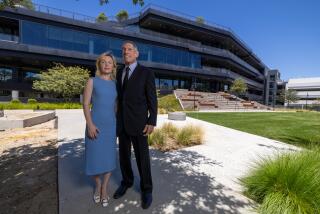Baldwin Hills Mall Bought by Chicago Realty Investor
Baldwin Hills Crenshaw Plaza, a shopping mainstay of South Los Angeles that has seen its share of ups and downs across six decades, has been sold for $136 million to a Chicago real estate investor that plans to improve and expand it.
Capri Capital Advisors on Wednesday said it acquired the 860,000-square-foot mall at the corner of Martin Luther King Jr. and Crenshaw boulevards from Hager Pacific Properties, an Encino investment firm. The price is twice what Hager paid for the property in 2003.
The mall is anchored by the Magic Johnson Theatres, an Albertsons supermarket and Robinsons-May, Sears and Wal-Mart stores. The complex is almost fully leased, but the buyer says it needs millions of dollars of upgrades as well as an expansion the firm plans to conduct in the next two years.
“We want the mall to be less an island unto itself and more a part of the community,” said Quintin E. Primo III, chairman and chief executive of Capri Capital, which specializes in upgrading urban properties.
“African Americans of moderate income shop at places other than dollar stores,” Primo said. “We like fresh food too, and hip urban clothes -- the same things that retail consumers like in the suburbs.”
The improvements may include more restaurants, more entertainment and perhaps even condominiums or apartments, Primo said. He added that there should be a mix of businesses that reflect the largely black and Latino neighborhoods nearby.
As a minority-owned business, Capri is better suited than most investors to connect with its urban clientele, Primo said. “We understand the culture.”
Operating the mall was a daily management challenge, said Adam Milstein, managing partner of seller Hager Pacific. He said he preferred to invest in industrial plants and retail locations with just one tenant and would use the proceeds from the mall sale to buy such properties in other major markets.
Investors’ attitudes about urban retail centers have changed since Hager Pacific acquired the mall in March 2003 for $68 million, Milstein said.
“Its reputation wasn’t the best,” he said of the mall, “and a lot of national tenants didn’t even want to look at it when we invited them.”
Shortly before Hager Pacific took over, Wal-Mart Stores Inc. opened its first three-story store in a building once occupied by a Broadway department store. Other national tenants followed, including Walden Books and Lane Bryant.
Sales increased from $350 a square foot in 2002 to almost $500 a square foot in 2005 for the non-anchor stores, Milstein said.
That far exceeds the national average of $366 a square foot reported in 2004, the latest year for which figures are available, according to the International Council of Shopping Centers.
The mall has improved in the last few years, said longtime Baldwin Hills resident Karen Chappelle, but it still has a way to go.
“Fashion-conscious women don’t go there to buy clothes, because they don’t have quality,” said Chappelle, a state deputy attorney general. “They kept saying they were going to get a big anchor store like Nordstrom, and it turned out to be Wal-Mart.”
Los Angeles limousine driver Johnny Chiles likes to spend time at the mall and stopped by Wednesday for a haircut.
The center is “cool,” he said, but could use a few more men’s shops. “It’s nice to see things have been built up since the riots.”
The 1992 civic unrest that hit hardest in central Los Angeles represented one of the lowest points in the mall’s history. Baldwin Hills Crenshaw Plaza traces its roots to 1947 with the opening of Broadway and May Co. stores, complemented by shops and restaurants.
In the 1980s, Mayor Tom Bradley wanted to see a major shopping center in the neighborhood and encouraged linking the stores to create an indoor mall. The plaza was the first project financed by the Los Angeles Community Redevelopment Agency; the $120-million project by Alexander Hagen & Co. was completed in 1988.
It scored some successes in the wake of the riots, as TJ Maxx, Foot Locker and See’s Candies signed on. In 1993, Gap Inc. moved in, but the chain pulled out after four years of steady losses.
The Magic Johnson Theatres have been successful since they opened in 1995, but the closure of Macy’s in 1998, which had replaced Broadway, left a void that dragged the mall down until Wal-Mart provided a lift three years ago.
The Community Redevelopment Agency is working on three projects in the Crenshaw area, including the $123-million Marlton Square commercial and residential project immediately west of the mall, said real estate broker Reza Etedali, who represented both parties in the Capri Capital-Hager Pacific deal.
Macy’s is expected to return to the mall because its parent company acquired Robinsons-May last year.
The complex is again positioned for growth as the neighborhood continues to improve economically, said Bobby Turner of Canyon-Johnson Urban Fund, which was among the bidders competing with Capri Capital.
“Merchandising has got to be tweaked, but the demographics make this mall an ideal opportunity,” said Turner, managing partner of Canyon-Johnson. “It’s an anchor of that community. They’re going to do great.”
The fund is a joint venture of Canyon Capital Realty Advisors and retired Laker star Earvin “Magic” Johnson’s Johnson Development Corp.
Harvard-educated entrepreneur Primo sold Capri Capital’s mortgage banking unit -- with a loan portfolio of $5.5 billion -- to CharterMac in March.
Capri Capital manages $2.7 billion in investments on behalf of pension funds and other institutional clients. This is Capri Capital’s biggest retail investment.
More to Read
Inside the business of entertainment
The Wide Shot brings you news, analysis and insights on everything from streaming wars to production — and what it all means for the future.
You may occasionally receive promotional content from the Los Angeles Times.











